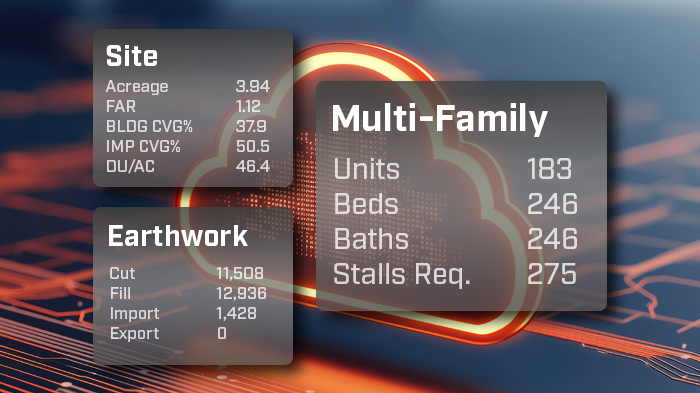
The pro-forma calls for X building units in order to make a project viable. This makes X, or better, the target to achieve for a density study. There are several levers to pull, but each lever has an impact on an overall design. To demonstrate these different concepts, I am using TestFit, a parametric multifamily modeling tool on a theoretical site. Any modeling tool will suffice for these levers, and should work with pencil on trace, CAD, or any other kind of workflow.
Here are some levers:
Lever 1: Lower the unit average
This option will require less space for each unit, therefore boosting the yield. This is a win right? Not so much. The market might be demanding larger units, and smaller units will grow construction cost per square foot. However, If I have some leeway I can get a few more units this way.
This adds ~10 units to the density study.
Lever 2: Grow the garage vertically
The point of this option is to minimize the footprint of the garage while maintaining the correct parking demand. If the footprint can be cut down significantly, the same area that used to be occupied by the garage can now be used for units. Is this a win? Depends upon what kind of construction is used for the garage, or if zoning caps the height of the garage. If it is capped, then below grade might be the answer (very expensive). If height is uncapped, an additional level of garage above the wrap building does not look too atrocious. Some designers use this as an opportunity for a "sky deck."
This adds ~10 units to the density study.
Lever 3: Increase unit depth
Consider the following two units.
- A1 is 25' wide, 30' deep, 750 NRSF
- A2 is 30' wide, 25' deep, 750 NRSF
To a pro-forma these units both represent the same thing, but spatially the A1 is significantly better to use from a unit yield perspective. On a 150' long building mass, 6 A1s fit and only 5 A2s fit. The major difference between these two units? not much. In Residential Engine we accomplish this by increasing the building mass width from 56' to 66'.
This adds ~15 units to the density study.
Lever 4: Add levels to the building
Probably the most simple solution. Going from 3 to 4 floors means there needs to be elevators. Going from 4 to 5 means a change in structure on floor 1. Going from 5 to 6 means another change in structure for floors 1 and 2. This is a simple way to boost unit yield, yet it is the costliest. I flipped to 3D mode for a better explanation of what is happening behind the math.
This strategy adds units, but with diminishing returns if the parking structure is not adjusted in vertical height (as it needs to grow horizontally to compensate for parking demand).
Lever 5: Remove or minimize balconies
If the building in question is in Texas, that balcony will be used to collect dust and provide horizontal sun shading for the unit below you (sorry top floor residents). The problem with "diving board" balconies? They push your entire building away from the perimeter of the property line, squeezing the whole building. This might not be a choice in many markets, however.
This strategy adds ~10 units, and does not require balconies to be removed completely.
Pulling Several Levers
In this example, I need 210 units for the economics to pencil. I will use several of the levers above to get there. After adjusting the mass width, adding a couple of levels to the garage, testing balconies, and lowering the average, I know what it takes to get to 210 on our theoretical site.
Using several strategies outlined above, our yield grew from 157 units to 210.
Have I missed any strategies? Let us know.







